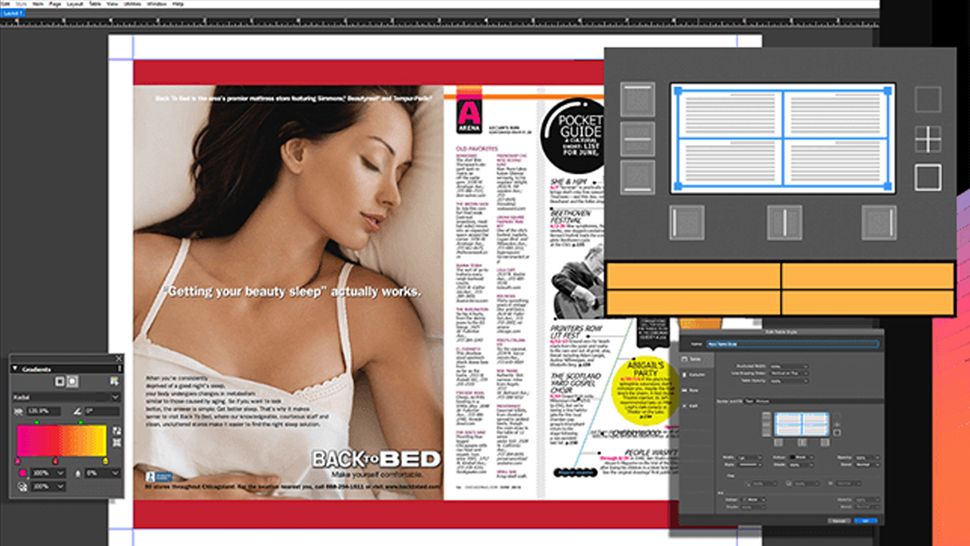

D’oh! Until now, there was no way to go back and recheck that word. Reverse spell checkĮvery InDesign user knows that moment when you’re running a spell check and get into the rhythm of quickly skipping words that don’t need to be changed and you accidentally click the Skip button for a word that does need be fixed. For people working with text in these Southeast Asian languages, this a very big deal. Support for Southeast Asian languagesĪdobe has added a new text engine called Harfbuzz to the World-Ready Paragraph Composer that improves rendering of script fonts for languages such as Thai, Burmese, Khmer, and Sinhala. We’ve been asking for some of these features for quite some time, so it’s nice to see them finally arrive. InDesign 2020 offers some notable text improvements that, while not groundbreaking, are still quite welcome. Page flipping effects, along with the rest of Flash, have gone the way of the dodo. Of course, the SWF Preview panel (whose sole purpose was to preview Flash animations) is gone, as is the Page Turn transition ( Figure 3).įigure 3. And within the application, all underlying traces of Flash have been removed from panels like Links, Media, Timing, Page Transitions, Object States, Buttons and Forms, and Animation. And in conjunction with this, the 2020 release of InDesign completely removes support for placing, importing, exporting, and linking to Flash files, including the FLV, F4V, and SWF formats. Gone in a FlashĪdobe has announced their decision to end development and distribution of the Adobe Flash Player in the near future. Don’t do it-that closes the (now hidden) document, and you’ll be left wondering what happened to your file. You’ll see a red “close” button in the upper left corner of the window, and you might be tempted to click it to leave the Home screen. However, the Home screen does have one big “gotcha,” at least on the Mac: let’s say you have a document open and then switch to the Home screen. Searches in the Home screen provide results from Adobe Help, Adobe Forums, Adobe Stock, and Your Work. This is in the area that used to be called the Application Bar, but it’s now nameless and can’t be turned off.įigure 2.

But you can also access the Home screen at any time by clicking its “house” icon ( Figure 1) in the top left corner of the InDesign workspace. Now, in InDesign 2020, the Start workspace has been replaced with the Home screen, which is displayed when you initially launch InDesign or any time you have no documents open. However, one major limitation of the Start workspace was that it became unavailable once you opened a document, and the only way to bring it back was to close all documents. The Start screen showed recent files that you had worked on and also offered access to both Adobe Stock and Adobe Help. In CC 2015, InDesign introduced the Start workspace as the initial view shown when you launched InDesign and had no document open.

I hope you’ll find, as I have, that some of these changes result in better usability and easier access to features. You’ll notice a few minor interface changes when working in InDesign 2020. Many of those sources have been removed in this release. In addition to overall performance improvements, Adobe has also worked hard to stamp out sources of document corruption that have resulted in lost work for some users. This version promises faster text composition when working with vertical justification in frames, balance columns, and span columns. In previous releases and in certain situations, it was common to be typing away in InDesign only to be forced to sit and wait for the display to catch up. Just as important as bug-fixing is improving app performance, and I’m happy to report that InDesign 2020 offers some significant improvements in that area that are sure to make your work easier. Thankfully, the InDesign team has been tracking these and working diligently to fix them! InDesign 2020 contains a long list of bug fixes to address crashes related to things like IDML import, GREP searches, cross-references, anchored tables, and CC Libraries. No matter what you use it for, you’ve likely encountered a bug or two along the way that stopped you in your tracks and forced you to come up with a workaround of some kind. InDesign is a big product with a big audience. Before we get to the cool new stuff, here are some under-the-hood changes that are sure to improve your day-to-day experience with InDesign. We all want to see whiz-bang features added to InDesign, but sometimes the really important changes are ones that you just can’t see. The InDesign 2020 splash screen The Intangibles


 0 kommentar(er)
0 kommentar(er)
